Digital Marketing Campaign Report: Eco-Care Skincare (2024)
VerifiedAdded on 2022/03/04
|27
|4553
|470
Report
AI Summary
This report details a digital marketing plan for Eco-Care, a new company specializing in sustainable and organic skincare products. The report begins with an introduction highlighting the impact of digital media on marketing and the rise of Gen Z as a key demographic. It outlines the purpose of the report, which is to develop a comprehensive digital marketing strategy for Eco-Care, aiming to increase brand awareness and sales. A thorough situation analysis is conducted, evaluating both the macro (PESTLE analysis of Hong Kong) and micro environments (Porter's Five Forces). A digital SWOT analysis identifies the company's strengths, weaknesses, opportunities, and threats. The report defines the company's mission and objectives, including SMART objectives and the RACE framework. It then delves into marketing strategies, focusing on customer segmentation, targeting, and positioning. A digital marketing campaign is illustrated, and the report concludes with an evaluation of the marketing plan. The report covers topics such as environmental factors, digital channels, and competitor analysis, providing a strategic roadmap for Eco-Care's market entry and growth.
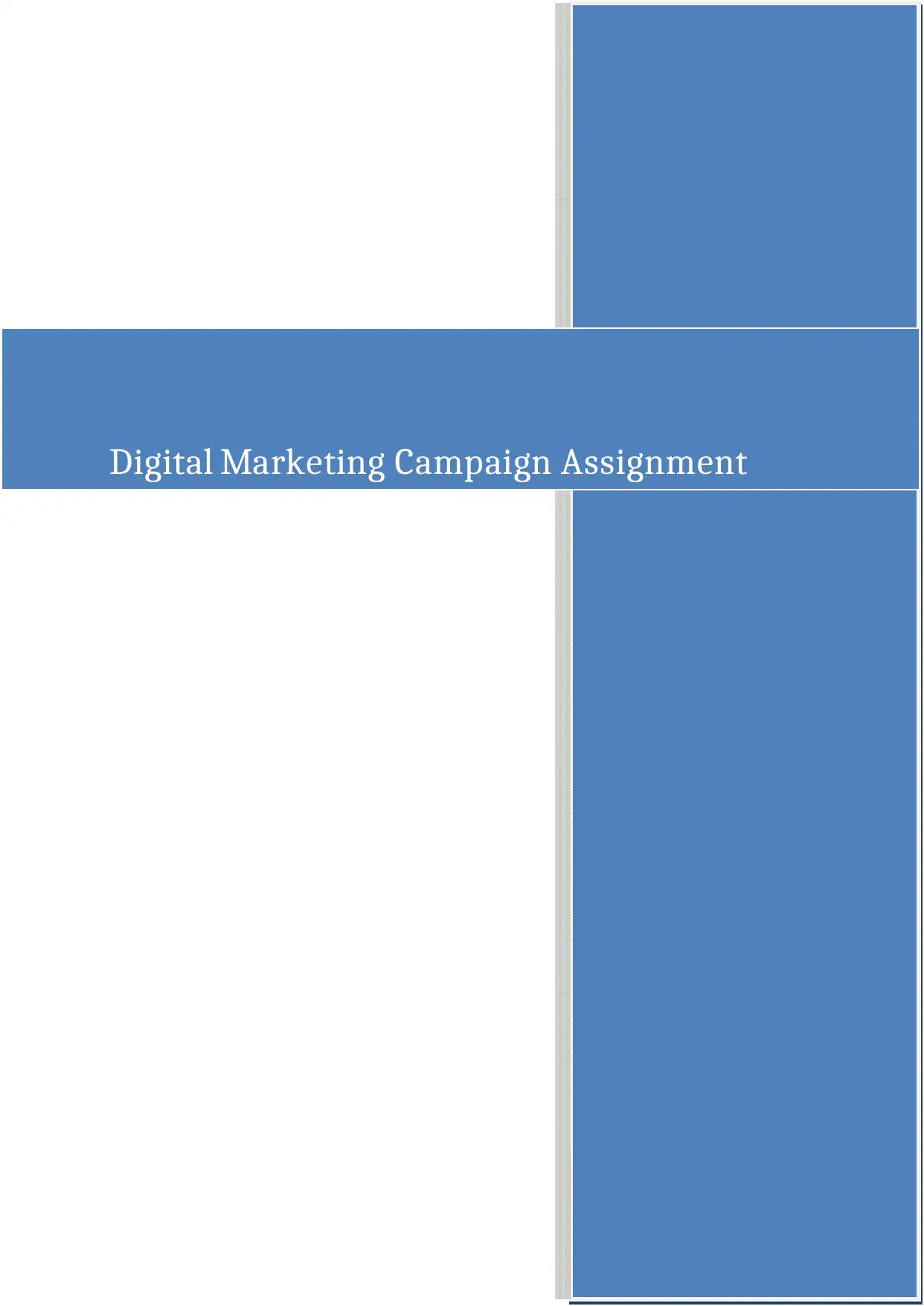
Digital Marketing Campaign Assignment
Paraphrase This Document
Need a fresh take? Get an instant paraphrase of this document with our AI Paraphraser
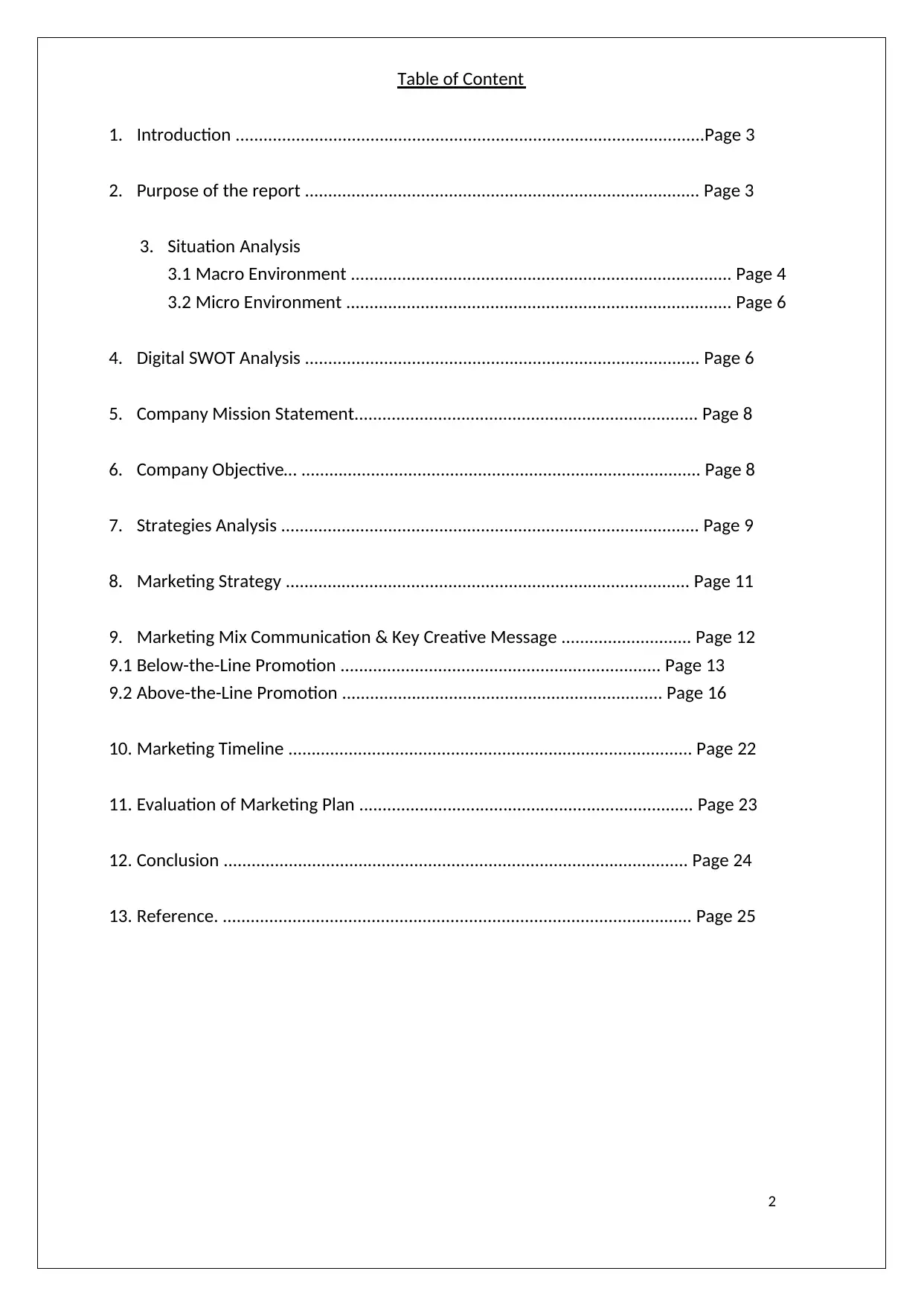
2
Table of Content
1. Introduction .....................................................................................................Page 3
2. Purpose of the report ..................................................................................... Page 3
3. Situation Analysis
3.1 Macro Environment .................................................................................. Page 4
3.2 Micro Environment ................................................................................... Page 6
4. Digital SWOT Analysis ..................................................................................... Page 6
5. Company Mission Statement.......................................................................... Page 8
6. Company Objective… ...................................................................................... Page 8
7. Strategies Analysis .......................................................................................... Page 9
8. Marketing Strategy ....................................................................................... Page 11
9. Marketing Mix Communication & Key Creative Message ............................ Page 12
9.1 Below-the-Line Promotion ..................................................................... Page 13
9.2 Above-the-Line Promotion ..................................................................... Page 16
10. Marketing Timeline ....................................................................................... Page 22
11. Evaluation of Marketing Plan ........................................................................ Page 23
12. Conclusion .................................................................................................... Page 24
13. Reference. ..................................................................................................... Page 25
Table of Content
1. Introduction .....................................................................................................Page 3
2. Purpose of the report ..................................................................................... Page 3
3. Situation Analysis
3.1 Macro Environment .................................................................................. Page 4
3.2 Micro Environment ................................................................................... Page 6
4. Digital SWOT Analysis ..................................................................................... Page 6
5. Company Mission Statement.......................................................................... Page 8
6. Company Objective… ...................................................................................... Page 8
7. Strategies Analysis .......................................................................................... Page 9
8. Marketing Strategy ....................................................................................... Page 11
9. Marketing Mix Communication & Key Creative Message ............................ Page 12
9.1 Below-the-Line Promotion ..................................................................... Page 13
9.2 Above-the-Line Promotion ..................................................................... Page 16
10. Marketing Timeline ....................................................................................... Page 22
11. Evaluation of Marketing Plan ........................................................................ Page 23
12. Conclusion .................................................................................................... Page 24
13. Reference. ..................................................................................................... Page 25
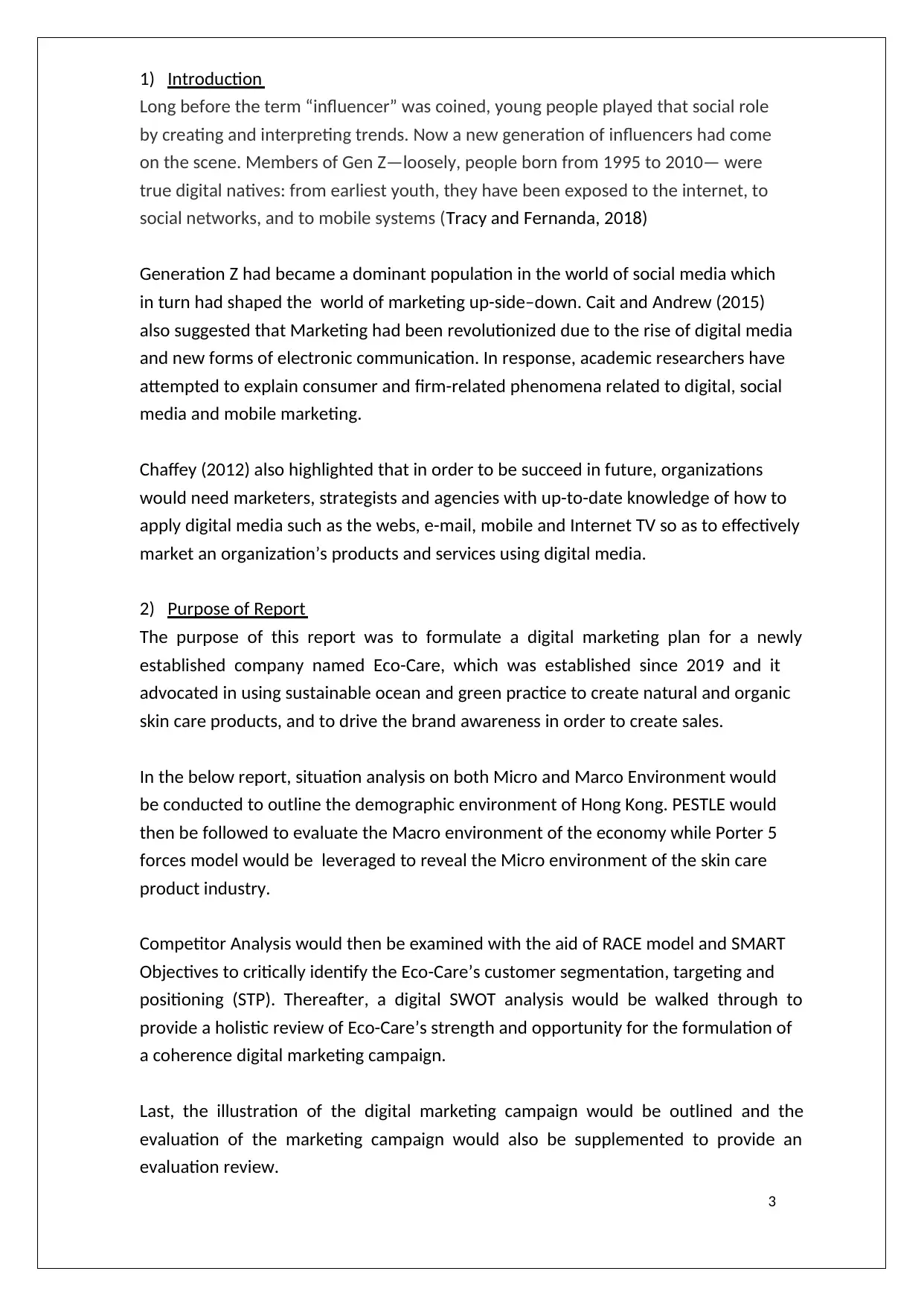
3
1) Introduction
Long before the term “influencer” was coined, young people played that social role
by creating and interpreting trends. Now a new generation of influencers had come
on the scene. Members of Gen Z—loosely, people born from 1995 to 2010— were
true digital natives: from earliest youth, they have been exposed to the internet, to
social networks, and to mobile systems (Tracy and Fernanda, 2018)
Generation Z had became a dominant population in the world of social media which
in turn had shaped the world of marketing up-side–down. Cait and Andrew (2015)
also suggested that Marketing had been revolutionized due to the rise of digital media
and new forms of electronic communication. In response, academic researchers have
attempted to explain consumer and firm-related phenomena related to digital, social
media and mobile marketing.
Chaffey (2012) also highlighted that in order to be succeed in future, organizations
would need marketers, strategists and agencies with up-to-date knowledge of how to
apply digital media such as the webs, e-mail, mobile and Internet TV so as to effectively
market an organization’s products and services using digital media.
2) Purpose of Report
The purpose of this report was to formulate a digital marketing plan for a newly
established company named Eco-Care, which was established since 2019 and it
advocated in using sustainable ocean and green practice to create natural and organic
skin care products, and to drive the brand awareness in order to create sales.
In the below report, situation analysis on both Micro and Marco Environment would
be conducted to outline the demographic environment of Hong Kong. PESTLE would
then be followed to evaluate the Macro environment of the economy while Porter 5
forces model would be leveraged to reveal the Micro environment of the skin care
product industry.
Competitor Analysis would then be examined with the aid of RACE model and SMART
Objectives to critically identify the Eco-Care’s customer segmentation, targeting and
positioning (STP). Thereafter, a digital SWOT analysis would be walked through to
provide a holistic review of Eco-Care’s strength and opportunity for the formulation of
a coherence digital marketing campaign.
Last, the illustration of the digital marketing campaign would be outlined and the
evaluation of the marketing campaign would also be supplemented to provide an
evaluation review.
1) Introduction
Long before the term “influencer” was coined, young people played that social role
by creating and interpreting trends. Now a new generation of influencers had come
on the scene. Members of Gen Z—loosely, people born from 1995 to 2010— were
true digital natives: from earliest youth, they have been exposed to the internet, to
social networks, and to mobile systems (Tracy and Fernanda, 2018)
Generation Z had became a dominant population in the world of social media which
in turn had shaped the world of marketing up-side–down. Cait and Andrew (2015)
also suggested that Marketing had been revolutionized due to the rise of digital media
and new forms of electronic communication. In response, academic researchers have
attempted to explain consumer and firm-related phenomena related to digital, social
media and mobile marketing.
Chaffey (2012) also highlighted that in order to be succeed in future, organizations
would need marketers, strategists and agencies with up-to-date knowledge of how to
apply digital media such as the webs, e-mail, mobile and Internet TV so as to effectively
market an organization’s products and services using digital media.
2) Purpose of Report
The purpose of this report was to formulate a digital marketing plan for a newly
established company named Eco-Care, which was established since 2019 and it
advocated in using sustainable ocean and green practice to create natural and organic
skin care products, and to drive the brand awareness in order to create sales.
In the below report, situation analysis on both Micro and Marco Environment would
be conducted to outline the demographic environment of Hong Kong. PESTLE would
then be followed to evaluate the Macro environment of the economy while Porter 5
forces model would be leveraged to reveal the Micro environment of the skin care
product industry.
Competitor Analysis would then be examined with the aid of RACE model and SMART
Objectives to critically identify the Eco-Care’s customer segmentation, targeting and
positioning (STP). Thereafter, a digital SWOT analysis would be walked through to
provide a holistic review of Eco-Care’s strength and opportunity for the formulation of
a coherence digital marketing campaign.
Last, the illustration of the digital marketing campaign would be outlined and the
evaluation of the marketing campaign would also be supplemented to provide an
evaluation review.
⊘ This is a preview!⊘
Do you want full access?
Subscribe today to unlock all pages.

Trusted by 1+ million students worldwide
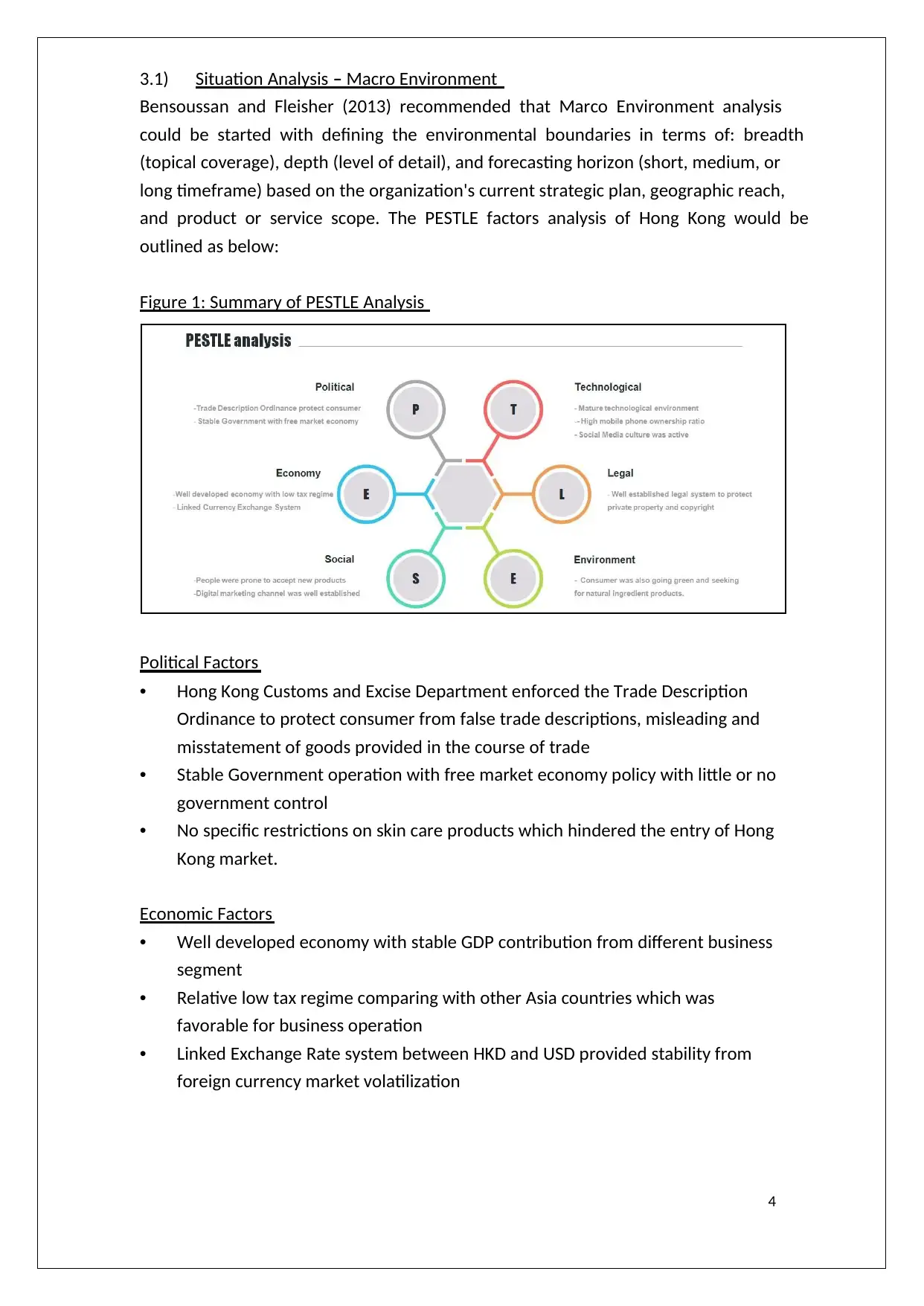
4
3.1) Situation Analysis – Macro Environment
Bensoussan and Fleisher (2013) recommended that Marco Environment analysis
could be started with defining the environmental boundaries in terms of: breadth
(topical coverage), depth (level of detail), and forecasting horizon (short, medium, or
long timeframe) based on the organization's current strategic plan, geographic reach,
and product or service scope. The PESTLE factors analysis of Hong Kong would be
outlined as below:
Figure 1: Summary of PESTLE Analysis
Political Factors
• Hong Kong Customs and Excise Department enforced the Trade Description
Ordinance to protect consumer from false trade descriptions, misleading and
misstatement of goods provided in the course of trade
• Stable Government operation with free market economy policy with little or no
government control
• No specific restrictions on skin care products which hindered the entry of Hong
Kong market.
Economic Factors
• Well developed economy with stable GDP contribution from different business
segment
• Relative low tax regime comparing with other Asia countries which was
favorable for business operation
• Linked Exchange Rate system between HKD and USD provided stability from
foreign currency market volatilization
3.1) Situation Analysis – Macro Environment
Bensoussan and Fleisher (2013) recommended that Marco Environment analysis
could be started with defining the environmental boundaries in terms of: breadth
(topical coverage), depth (level of detail), and forecasting horizon (short, medium, or
long timeframe) based on the organization's current strategic plan, geographic reach,
and product or service scope. The PESTLE factors analysis of Hong Kong would be
outlined as below:
Figure 1: Summary of PESTLE Analysis
Political Factors
• Hong Kong Customs and Excise Department enforced the Trade Description
Ordinance to protect consumer from false trade descriptions, misleading and
misstatement of goods provided in the course of trade
• Stable Government operation with free market economy policy with little or no
government control
• No specific restrictions on skin care products which hindered the entry of Hong
Kong market.
Economic Factors
• Well developed economy with stable GDP contribution from different business
segment
• Relative low tax regime comparing with other Asia countries which was
favorable for business operation
• Linked Exchange Rate system between HKD and USD provided stability from
foreign currency market volatilization
Paraphrase This Document
Need a fresh take? Get an instant paraphrase of this document with our AI Paraphraser
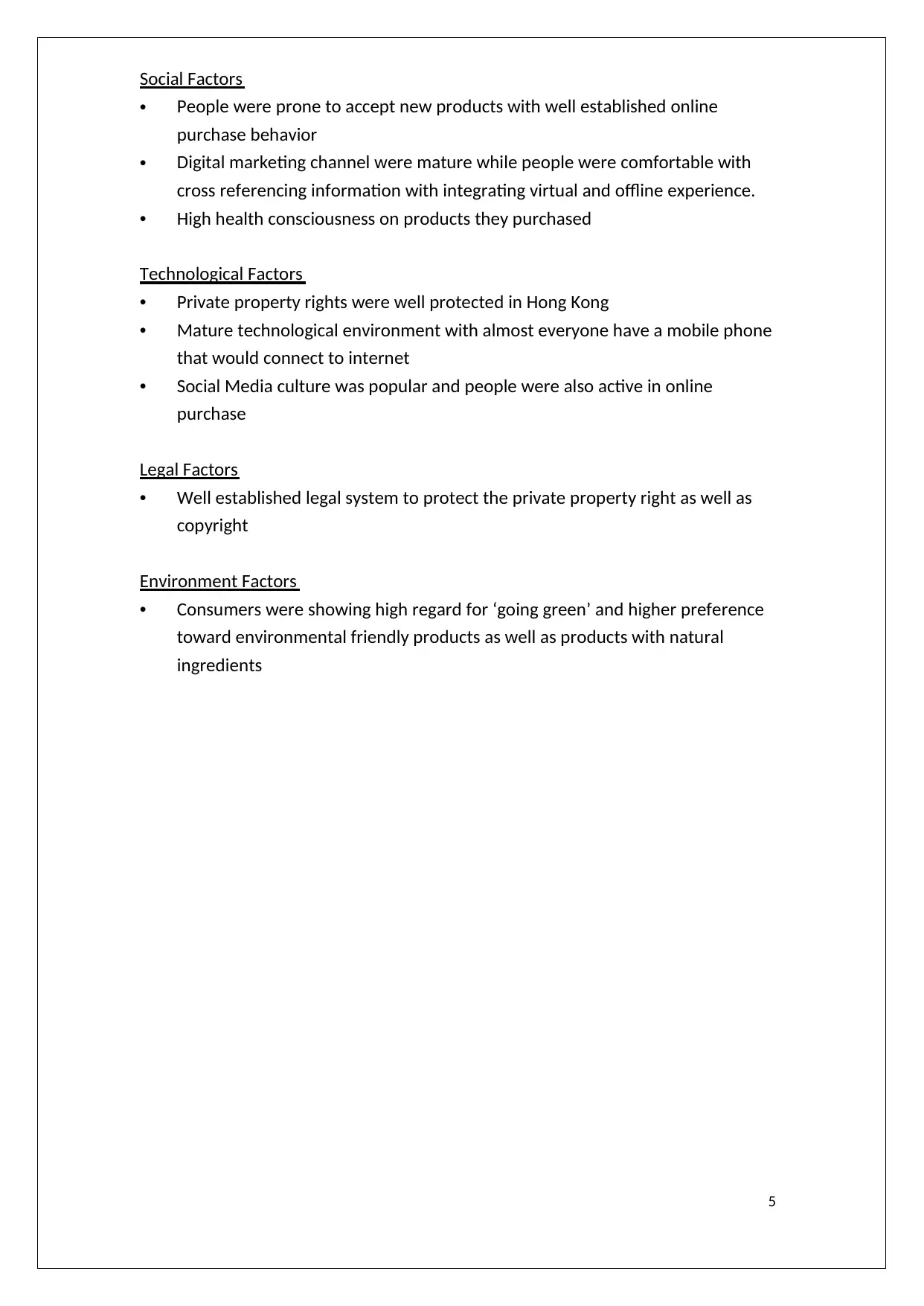
5
Social Factors
• People were prone to accept new products with well established online
purchase behavior
• Digital marketing channel were mature while people were comfortable with
cross referencing information with integrating virtual and offline experience.
• High health consciousness on products they purchased
Technological Factors
• Private property rights were well protected in Hong Kong
• Mature technological environment with almost everyone have a mobile phone
that would connect to internet
• Social Media culture was popular and people were also active in online
purchase
Legal Factors
• Well established legal system to protect the private property right as well as
copyright
Environment Factors
• Consumers were showing high regard for ‘going green’ and higher preference
toward environmental friendly products as well as products with natural
ingredients
Social Factors
• People were prone to accept new products with well established online
purchase behavior
• Digital marketing channel were mature while people were comfortable with
cross referencing information with integrating virtual and offline experience.
• High health consciousness on products they purchased
Technological Factors
• Private property rights were well protected in Hong Kong
• Mature technological environment with almost everyone have a mobile phone
that would connect to internet
• Social Media culture was popular and people were also active in online
purchase
Legal Factors
• Well established legal system to protect the private property right as well as
copyright
Environment Factors
• Consumers were showing high regard for ‘going green’ and higher preference
toward environmental friendly products as well as products with natural
ingredients
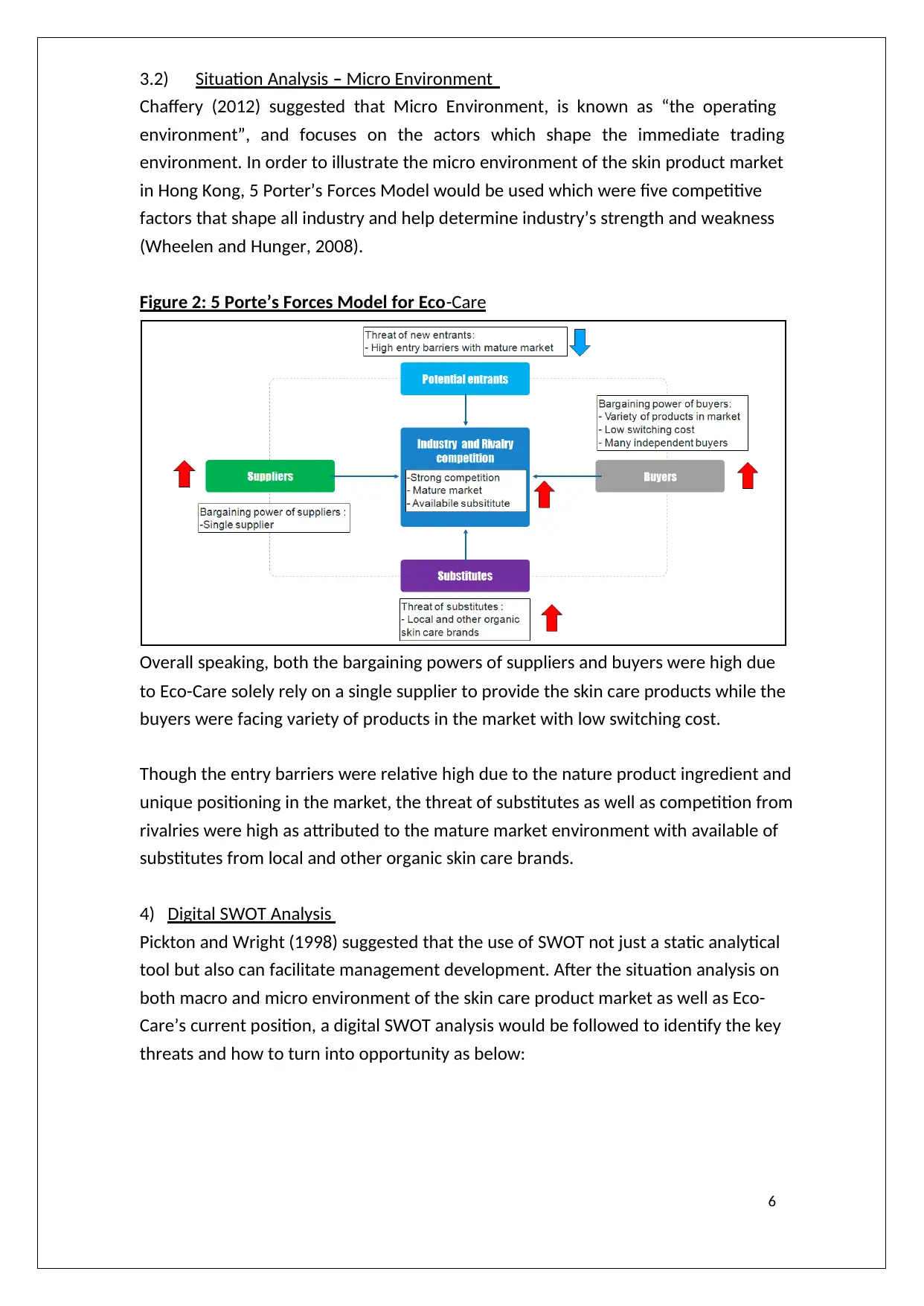
6
3.2) Situation Analysis – Micro Environment
Chaffery (2012) suggested that Micro Environment, is known as “the operating
environment”, and focuses on the actors which shape the immediate trading
environment. In order to illustrate the micro environment of the skin product market
in Hong Kong, 5 Porter’s Forces Model would be used which were five competitive
factors that shape all industry and help determine industry’s strength and weakness
(Wheelen and Hunger, 2008).
Figure 2: 5 Porte’s Forces Model for Eco-Care
Overall speaking, both the bargaining powers of suppliers and buyers were high due
to Eco-Care solely rely on a single supplier to provide the skin care products while the
buyers were facing variety of products in the market with low switching cost.
Though the entry barriers were relative high due to the nature product ingredient and
unique positioning in the market, the threat of substitutes as well as competition from
rivalries were high as attributed to the mature market environment with available of
substitutes from local and other organic skin care brands.
4) Digital SWOT Analysis
Pickton and Wright (1998) suggested that the use of SWOT not just a static analytical
tool but also can facilitate management development. After the situation analysis on
both macro and micro environment of the skin care product market as well as Eco-
Care’s current position, a digital SWOT analysis would be followed to identify the key
threats and how to turn into opportunity as below:
3.2) Situation Analysis – Micro Environment
Chaffery (2012) suggested that Micro Environment, is known as “the operating
environment”, and focuses on the actors which shape the immediate trading
environment. In order to illustrate the micro environment of the skin product market
in Hong Kong, 5 Porter’s Forces Model would be used which were five competitive
factors that shape all industry and help determine industry’s strength and weakness
(Wheelen and Hunger, 2008).
Figure 2: 5 Porte’s Forces Model for Eco-Care
Overall speaking, both the bargaining powers of suppliers and buyers were high due
to Eco-Care solely rely on a single supplier to provide the skin care products while the
buyers were facing variety of products in the market with low switching cost.
Though the entry barriers were relative high due to the nature product ingredient and
unique positioning in the market, the threat of substitutes as well as competition from
rivalries were high as attributed to the mature market environment with available of
substitutes from local and other organic skin care brands.
4) Digital SWOT Analysis
Pickton and Wright (1998) suggested that the use of SWOT not just a static analytical
tool but also can facilitate management development. After the situation analysis on
both macro and micro environment of the skin care product market as well as Eco-
Care’s current position, a digital SWOT analysis would be followed to identify the key
threats and how to turn into opportunity as below:
⊘ This is a preview!⊘
Do you want full access?
Subscribe today to unlock all pages.

Trusted by 1+ million students worldwide
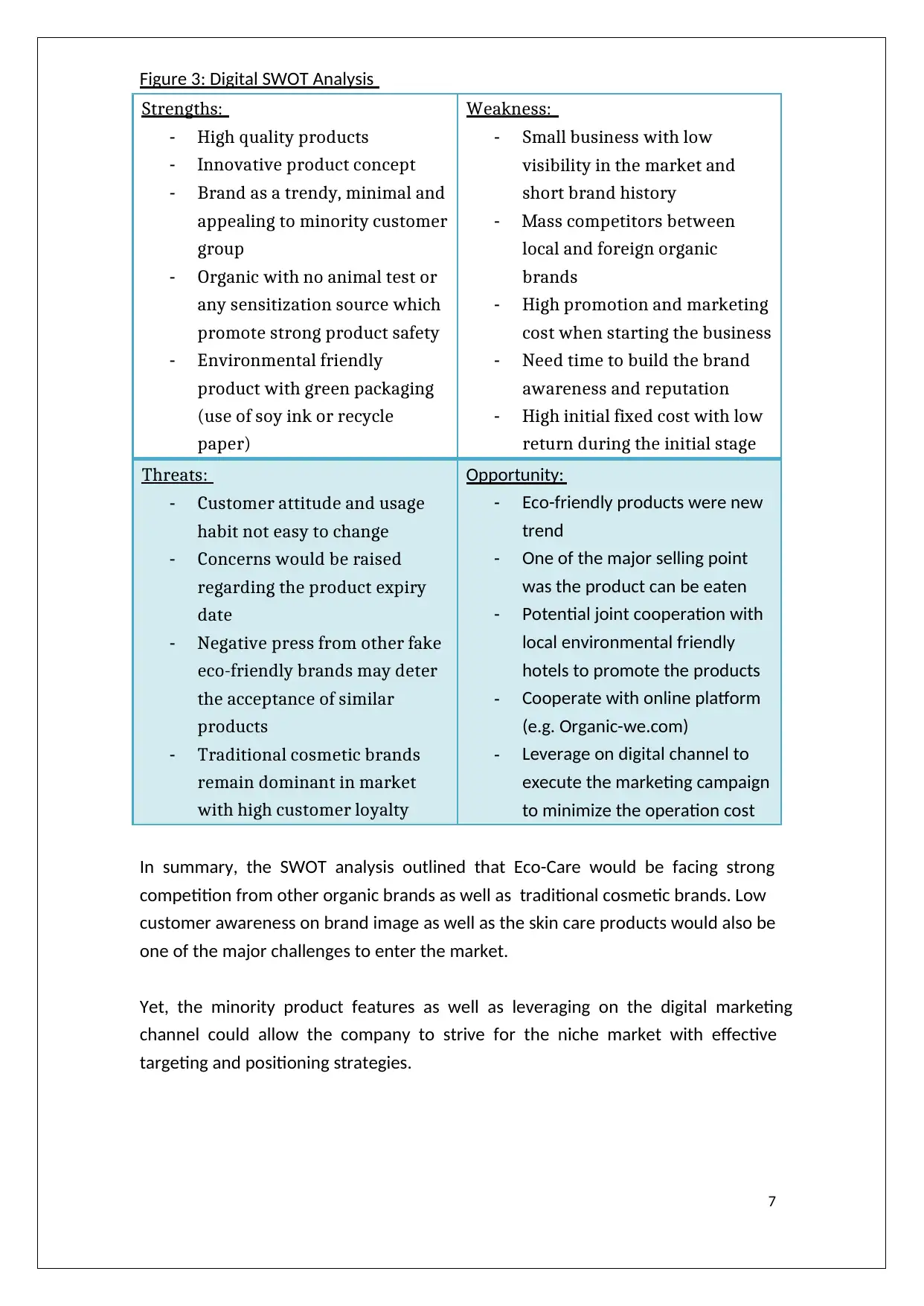
7
Figure 3: Digital SWOT Analysis
Strengths:
- High quality products
- Innovative product concept
- Brand as a trendy, minimal and
appealing to minority customer
group
- Organic with no animal test or
any sensitization source which
promote strong product safety
- Environmental friendly
product with green packaging
(use of soy ink or recycle
paper)
Weakness:
- Small business with low
visibility in the market and
short brand history
- Mass competitors between
local and foreign organic
brands
- High promotion and marketing
cost when starting the business
- Need time to build the brand
awareness and reputation
- High initial fixed cost with low
return during the initial stage
Threats:
- Customer attitude and usage
habit not easy to change
- Concerns would be raised
regarding the product expiry
date
- Negative press from other fake
eco-friendly brands may deter
the acceptance of similar
products
- Traditional cosmetic brands
remain dominant in market
with high customer loyalty
Opportunity:
- Eco-friendly products were new
trend
- One of the major selling point
was the product can be eaten
- Potential joint cooperation with
local environmental friendly
hotels to promote the products
- Cooperate with online platform
(e.g. Organic-we.com)
- Leverage on digital channel to
execute the marketing campaign
to minimize the operation cost
In summary, the SWOT analysis outlined that Eco-Care would be facing strong
competition from other organic brands as well as traditional cosmetic brands. Low
customer awareness on brand image as well as the skin care products would also be
one of the major challenges to enter the market.
Yet, the minority product features as well as leveraging on the digital marketing
channel could allow the company to strive for the niche market with effective
targeting and positioning strategies.
Figure 3: Digital SWOT Analysis
Strengths:
- High quality products
- Innovative product concept
- Brand as a trendy, minimal and
appealing to minority customer
group
- Organic with no animal test or
any sensitization source which
promote strong product safety
- Environmental friendly
product with green packaging
(use of soy ink or recycle
paper)
Weakness:
- Small business with low
visibility in the market and
short brand history
- Mass competitors between
local and foreign organic
brands
- High promotion and marketing
cost when starting the business
- Need time to build the brand
awareness and reputation
- High initial fixed cost with low
return during the initial stage
Threats:
- Customer attitude and usage
habit not easy to change
- Concerns would be raised
regarding the product expiry
date
- Negative press from other fake
eco-friendly brands may deter
the acceptance of similar
products
- Traditional cosmetic brands
remain dominant in market
with high customer loyalty
Opportunity:
- Eco-friendly products were new
trend
- One of the major selling point
was the product can be eaten
- Potential joint cooperation with
local environmental friendly
hotels to promote the products
- Cooperate with online platform
(e.g. Organic-we.com)
- Leverage on digital channel to
execute the marketing campaign
to minimize the operation cost
In summary, the SWOT analysis outlined that Eco-Care would be facing strong
competition from other organic brands as well as traditional cosmetic brands. Low
customer awareness on brand image as well as the skin care products would also be
one of the major challenges to enter the market.
Yet, the minority product features as well as leveraging on the digital marketing
channel could allow the company to strive for the niche market with effective
targeting and positioning strategies.
Paraphrase This Document
Need a fresh take? Get an instant paraphrase of this document with our AI Paraphraser
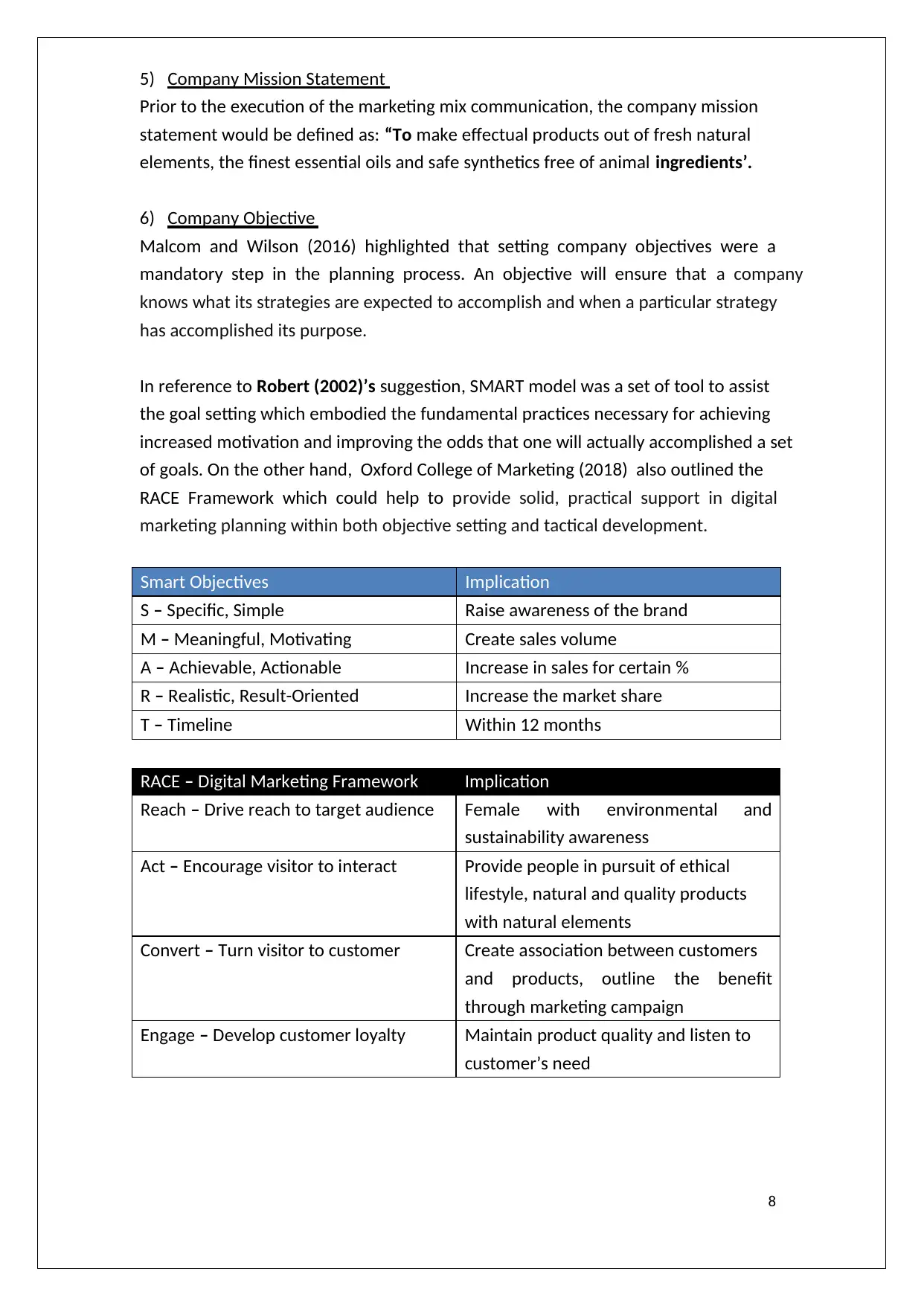
8
5) Company Mission Statement
Prior to the execution of the marketing mix communication, the company mission
statement would be defined as: “To make effectual products out of fresh natural
elements, the finest essential oils and safe synthetics free of animal ingredients’.
6) Company Objective
Malcom and Wilson (2016) highlighted that setting company objectives were a
mandatory step in the planning process. An objective will ensure that a company
knows what its strategies are expected to accomplish and when a particular strategy
has accomplished its purpose.
In reference to Robert (2002)’s suggestion, SMART model was a set of tool to assist
the goal setting which embodied the fundamental practices necessary for achieving
increased motivation and improving the odds that one will actually accomplished a set
of goals. On the other hand, Oxford College of Marketing (2018) also outlined the
RACE Framework which could help to provide solid, practical support in digital
marketing planning within both objective setting and tactical development.
Smart Objectives Implication
S – Specific, Simple Raise awareness of the brand
M – Meaningful, Motivating Create sales volume
A – Achievable, Actionable Increase in sales for certain %
R – Realistic, Result-Oriented Increase the market share
T – Timeline Within 12 months
RACE – Digital Marketing Framework Implication
Reach – Drive reach to target audience Female with environmental and
sustainability awareness
Act – Encourage visitor to interact Provide people in pursuit of ethical
lifestyle, natural and quality products
with natural elements
Convert – Turn visitor to customer Create association between customers
and products, outline the benefit
through marketing campaign
Engage – Develop customer loyalty Maintain product quality and listen to
customer’s need
5) Company Mission Statement
Prior to the execution of the marketing mix communication, the company mission
statement would be defined as: “To make effectual products out of fresh natural
elements, the finest essential oils and safe synthetics free of animal ingredients’.
6) Company Objective
Malcom and Wilson (2016) highlighted that setting company objectives were a
mandatory step in the planning process. An objective will ensure that a company
knows what its strategies are expected to accomplish and when a particular strategy
has accomplished its purpose.
In reference to Robert (2002)’s suggestion, SMART model was a set of tool to assist
the goal setting which embodied the fundamental practices necessary for achieving
increased motivation and improving the odds that one will actually accomplished a set
of goals. On the other hand, Oxford College of Marketing (2018) also outlined the
RACE Framework which could help to provide solid, practical support in digital
marketing planning within both objective setting and tactical development.
Smart Objectives Implication
S – Specific, Simple Raise awareness of the brand
M – Meaningful, Motivating Create sales volume
A – Achievable, Actionable Increase in sales for certain %
R – Realistic, Result-Oriented Increase the market share
T – Timeline Within 12 months
RACE – Digital Marketing Framework Implication
Reach – Drive reach to target audience Female with environmental and
sustainability awareness
Act – Encourage visitor to interact Provide people in pursuit of ethical
lifestyle, natural and quality products
with natural elements
Convert – Turn visitor to customer Create association between customers
and products, outline the benefit
through marketing campaign
Engage – Develop customer loyalty Maintain product quality and listen to
customer’s need
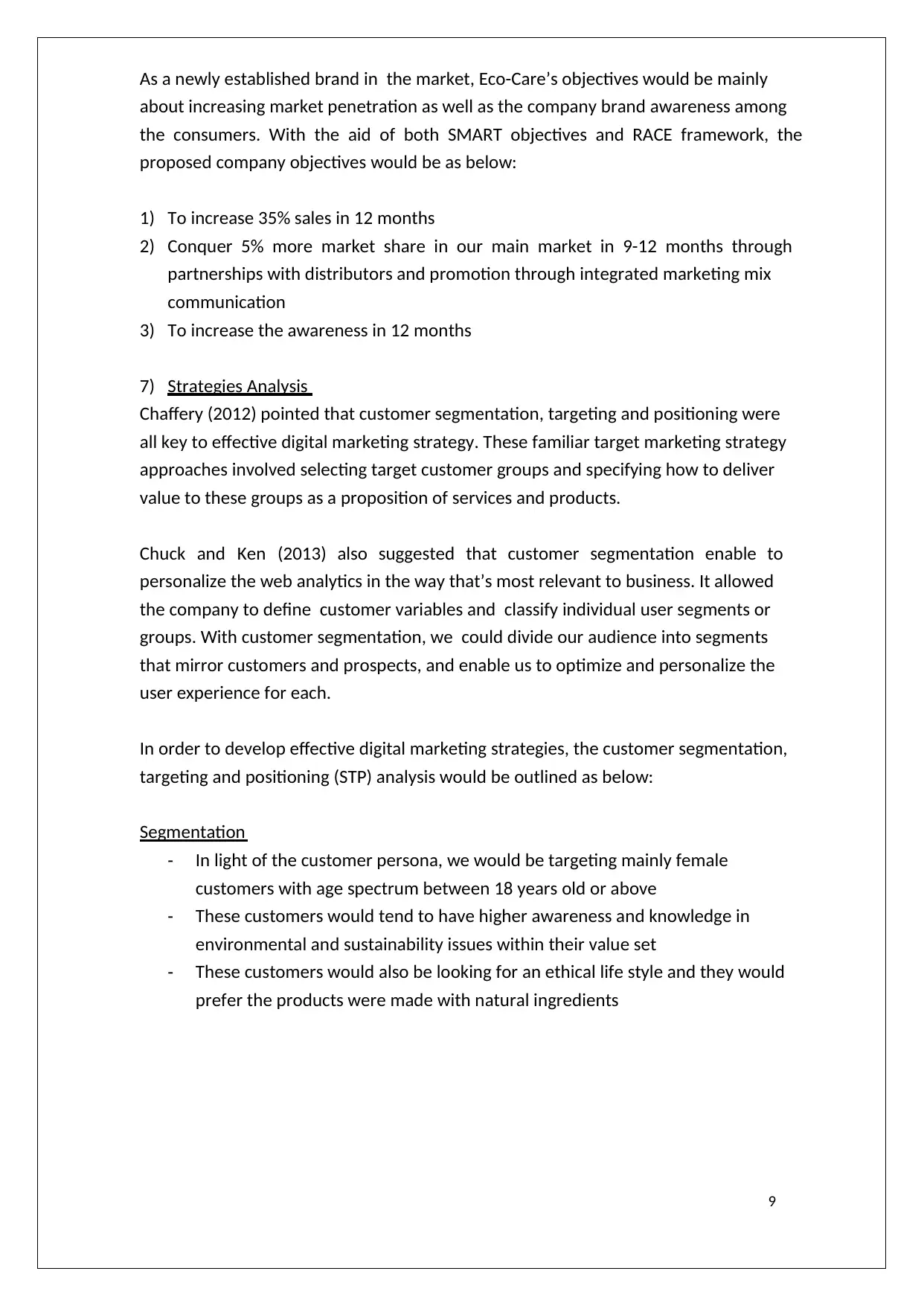
9
As a newly established brand in the market, Eco-Care’s objectives would be mainly
about increasing market penetration as well as the company brand awareness among
the consumers. With the aid of both SMART objectives and RACE framework, the
proposed company objectives would be as below:
1) To increase 35% sales in 12 months
2) Conquer 5% more market share in our main market in 9-12 months through
partnerships with distributors and promotion through integrated marketing mix
communication
3) To increase the awareness in 12 months
7) Strategies Analysis
Chaffery (2012) pointed that customer segmentation, targeting and positioning were
all key to effective digital marketing strategy. These familiar target marketing strategy
approaches involved selecting target customer groups and specifying how to deliver
value to these groups as a proposition of services and products.
Chuck and Ken (2013) also suggested that customer segmentation enable to
personalize the web analytics in the way that’s most relevant to business. It allowed
the company to define customer variables and classify individual user segments or
groups. With customer segmentation, we could divide our audience into segments
that mirror customers and prospects, and enable us to optimize and personalize the
user experience for each.
In order to develop effective digital marketing strategies, the customer segmentation,
targeting and positioning (STP) analysis would be outlined as below:
Segmentation
- In light of the customer persona, we would be targeting mainly female
customers with age spectrum between 18 years old or above
- These customers would tend to have higher awareness and knowledge in
environmental and sustainability issues within their value set
- These customers would also be looking for an ethical life style and they would
prefer the products were made with natural ingredients
As a newly established brand in the market, Eco-Care’s objectives would be mainly
about increasing market penetration as well as the company brand awareness among
the consumers. With the aid of both SMART objectives and RACE framework, the
proposed company objectives would be as below:
1) To increase 35% sales in 12 months
2) Conquer 5% more market share in our main market in 9-12 months through
partnerships with distributors and promotion through integrated marketing mix
communication
3) To increase the awareness in 12 months
7) Strategies Analysis
Chaffery (2012) pointed that customer segmentation, targeting and positioning were
all key to effective digital marketing strategy. These familiar target marketing strategy
approaches involved selecting target customer groups and specifying how to deliver
value to these groups as a proposition of services and products.
Chuck and Ken (2013) also suggested that customer segmentation enable to
personalize the web analytics in the way that’s most relevant to business. It allowed
the company to define customer variables and classify individual user segments or
groups. With customer segmentation, we could divide our audience into segments
that mirror customers and prospects, and enable us to optimize and personalize the
user experience for each.
In order to develop effective digital marketing strategies, the customer segmentation,
targeting and positioning (STP) analysis would be outlined as below:
Segmentation
- In light of the customer persona, we would be targeting mainly female
customers with age spectrum between 18 years old or above
- These customers would tend to have higher awareness and knowledge in
environmental and sustainability issues within their value set
- These customers would also be looking for an ethical life style and they would
prefer the products were made with natural ingredients
⊘ This is a preview!⊘
Do you want full access?
Subscribe today to unlock all pages.

Trusted by 1+ million students worldwide
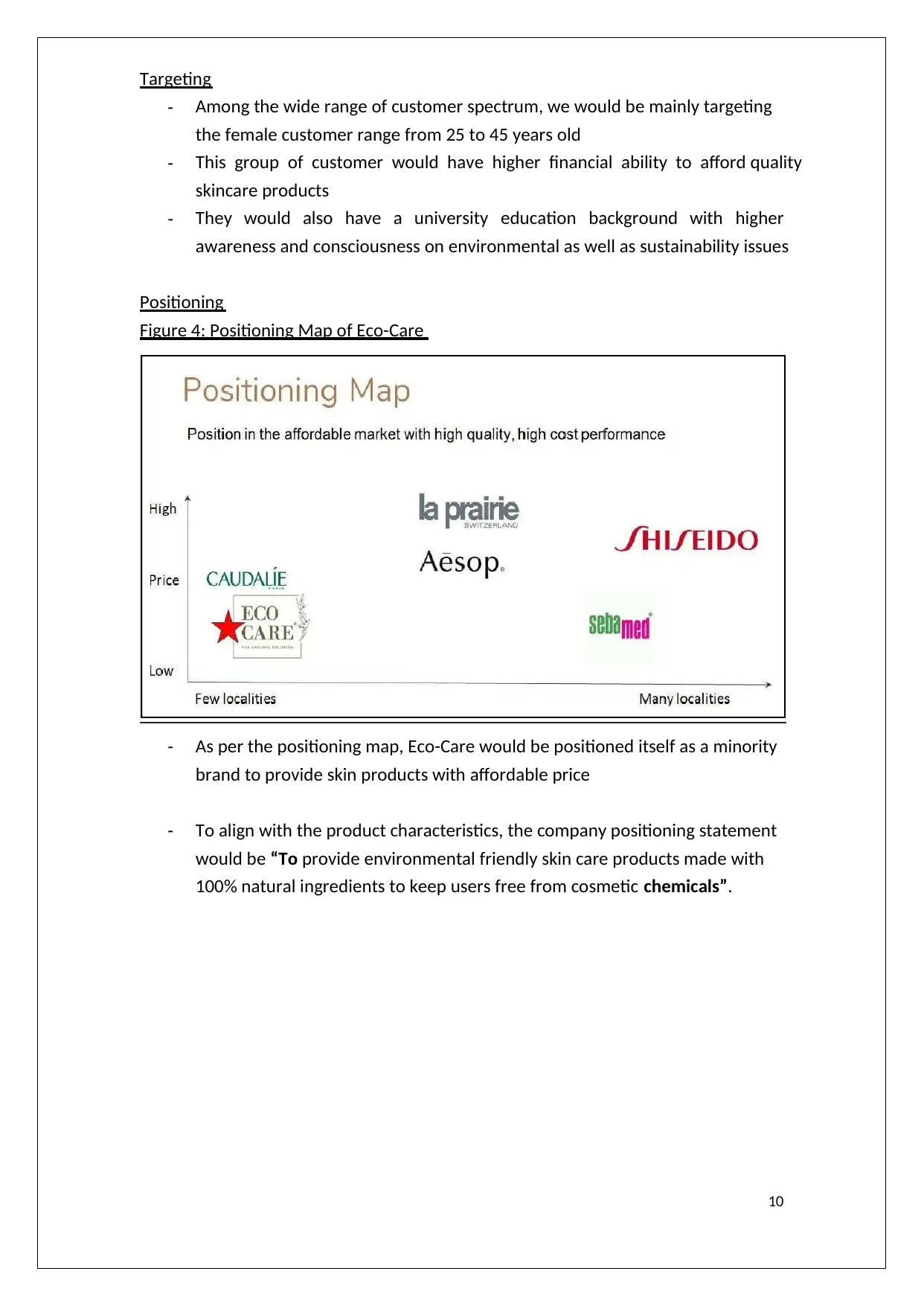
10
Targeting
- Among the wide range of customer spectrum, we would be mainly targeting
the female customer range from 25 to 45 years old
- This group of customer would have higher financial ability to afford quality
skincare products
- They would also have a university education background with higher
awareness and consciousness on environmental as well as sustainability issues
Positioning
Figure 4: Positioning Map of Eco-Care
- As per the positioning map, Eco-Care would be positioned itself as a minority
brand to provide skin products with affordable price
- To align with the product characteristics, the company positioning statement
would be “To provide environmental friendly skin care products made with
100% natural ingredients to keep users free from cosmetic chemicals”.
Targeting
- Among the wide range of customer spectrum, we would be mainly targeting
the female customer range from 25 to 45 years old
- This group of customer would have higher financial ability to afford quality
skincare products
- They would also have a university education background with higher
awareness and consciousness on environmental as well as sustainability issues
Positioning
Figure 4: Positioning Map of Eco-Care
- As per the positioning map, Eco-Care would be positioned itself as a minority
brand to provide skin products with affordable price
- To align with the product characteristics, the company positioning statement
would be “To provide environmental friendly skin care products made with
100% natural ingredients to keep users free from cosmetic chemicals”.
Paraphrase This Document
Need a fresh take? Get an instant paraphrase of this document with our AI Paraphraser
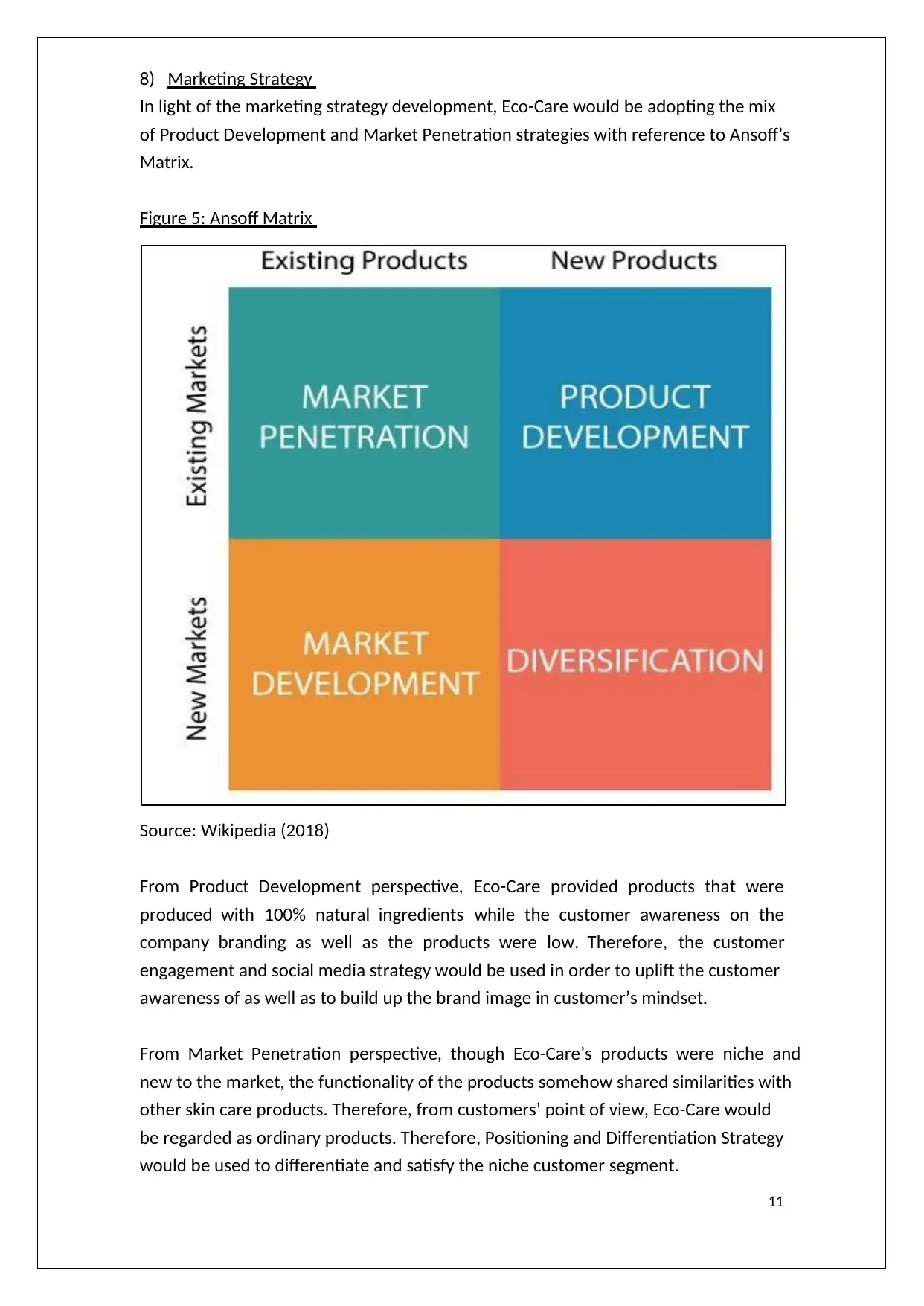
11
8) Marketing Strategy
In light of the marketing strategy development, Eco-Care would be adopting the mix
of Product Development and Market Penetration strategies with reference to Ansoff’s
Matrix.
Figure 5: Ansoff Matrix
Source: Wikipedia (2018)
From Product Development perspective, Eco-Care provided products that were
produced with 100% natural ingredients while the customer awareness on the
company branding as well as the products were low. Therefore, the customer
engagement and social media strategy would be used in order to uplift the customer
awareness of as well as to build up the brand image in customer’s mindset.
From Market Penetration perspective, though Eco-Care’s products were niche and
new to the market, the functionality of the products somehow shared similarities with
other skin care products. Therefore, from customers’ point of view, Eco-Care would
be regarded as ordinary products. Therefore, Positioning and Differentiation Strategy
would be used to differentiate and satisfy the niche customer segment.
8) Marketing Strategy
In light of the marketing strategy development, Eco-Care would be adopting the mix
of Product Development and Market Penetration strategies with reference to Ansoff’s
Matrix.
Figure 5: Ansoff Matrix
Source: Wikipedia (2018)
From Product Development perspective, Eco-Care provided products that were
produced with 100% natural ingredients while the customer awareness on the
company branding as well as the products were low. Therefore, the customer
engagement and social media strategy would be used in order to uplift the customer
awareness of as well as to build up the brand image in customer’s mindset.
From Market Penetration perspective, though Eco-Care’s products were niche and
new to the market, the functionality of the products somehow shared similarities with
other skin care products. Therefore, from customers’ point of view, Eco-Care would
be regarded as ordinary products. Therefore, Positioning and Differentiation Strategy
would be used to differentiate and satisfy the niche customer segment.
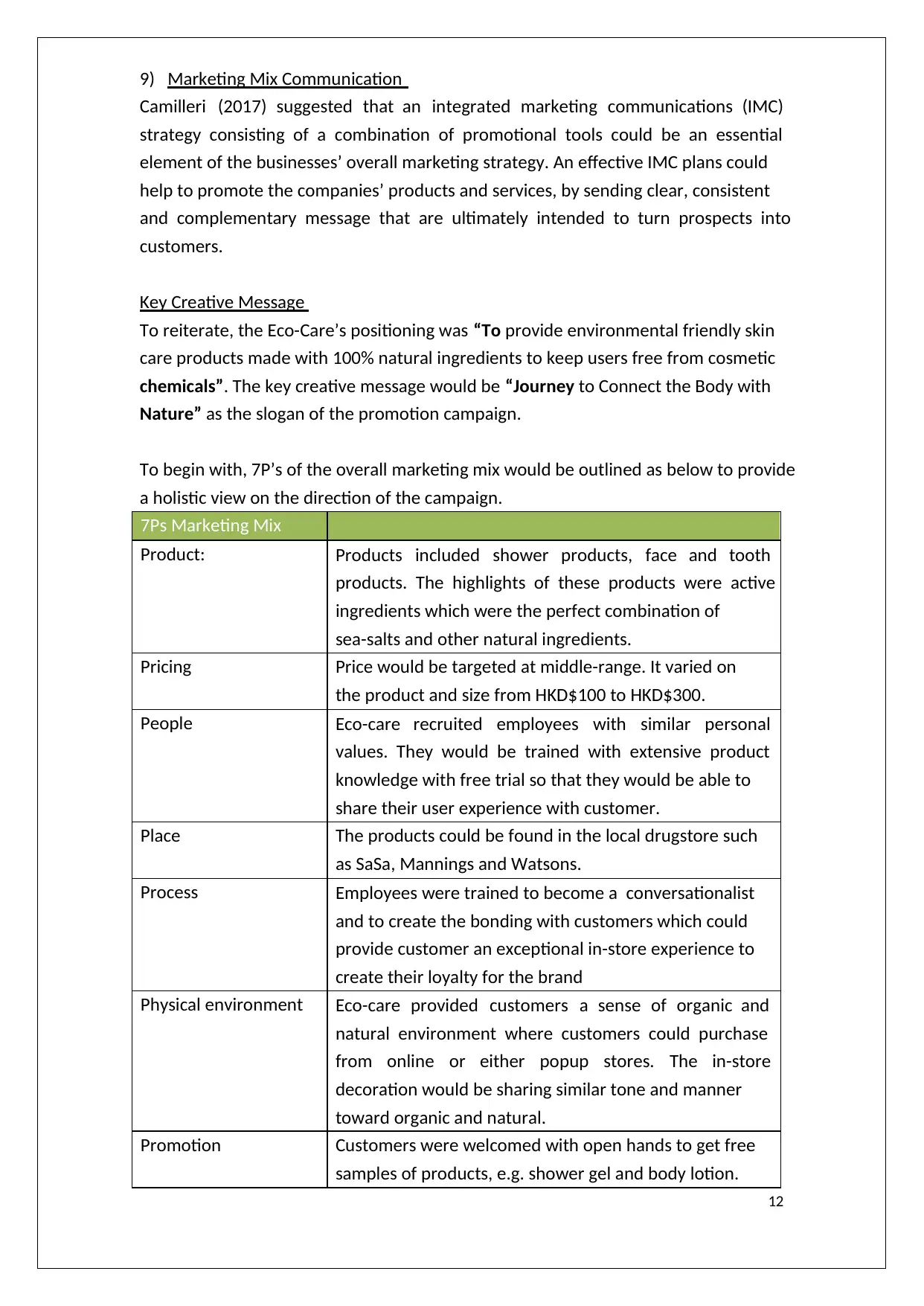
12
9) Marketing Mix Communication
Camilleri (2017) suggested that an integrated marketing communications (IMC)
strategy consisting of a combination of promotional tools could be an essential
element of the businesses’ overall marketing strategy. An effective IMC plans could
help to promote the companies’ products and services, by sending clear, consistent
and complementary message that are ultimately intended to turn prospects into
customers.
Key Creative Message
To reiterate, the Eco-Care’s positioning was “To provide environmental friendly skin
care products made with 100% natural ingredients to keep users free from cosmetic
chemicals”. The key creative message would be “Journey to Connect the Body with
Nature” as the slogan of the promotion campaign.
To begin with, 7P’s of the overall marketing mix would be outlined as below to provide
a holistic view on the direction of the campaign.
7Ps Marketing Mix
Product: Products included shower products, face and tooth
products. The highlights of these products were active
ingredients which were the perfect combination of
sea-salts and other natural ingredients.
Pricing Price would be targeted at middle-range. It varied on
the product and size from HKD$100 to HKD$300.
People Eco-care recruited employees with similar personal
values. They would be trained with extensive product
knowledge with free trial so that they would be able to
share their user experience with customer.
Place The products could be found in the local drugstore such
as SaSa, Mannings and Watsons.
Process Employees were trained to become a conversationalist
and to create the bonding with customers which could
provide customer an exceptional in-store experience to
create their loyalty for the brand
Physical environment Eco-care provided customers a sense of organic and
natural environment where customers could purchase
from online or either popup stores. The in-store
decoration would be sharing similar tone and manner
toward organic and natural.
Promotion Customers were welcomed with open hands to get free
samples of products, e.g. shower gel and body lotion.
9) Marketing Mix Communication
Camilleri (2017) suggested that an integrated marketing communications (IMC)
strategy consisting of a combination of promotional tools could be an essential
element of the businesses’ overall marketing strategy. An effective IMC plans could
help to promote the companies’ products and services, by sending clear, consistent
and complementary message that are ultimately intended to turn prospects into
customers.
Key Creative Message
To reiterate, the Eco-Care’s positioning was “To provide environmental friendly skin
care products made with 100% natural ingredients to keep users free from cosmetic
chemicals”. The key creative message would be “Journey to Connect the Body with
Nature” as the slogan of the promotion campaign.
To begin with, 7P’s of the overall marketing mix would be outlined as below to provide
a holistic view on the direction of the campaign.
7Ps Marketing Mix
Product: Products included shower products, face and tooth
products. The highlights of these products were active
ingredients which were the perfect combination of
sea-salts and other natural ingredients.
Pricing Price would be targeted at middle-range. It varied on
the product and size from HKD$100 to HKD$300.
People Eco-care recruited employees with similar personal
values. They would be trained with extensive product
knowledge with free trial so that they would be able to
share their user experience with customer.
Place The products could be found in the local drugstore such
as SaSa, Mannings and Watsons.
Process Employees were trained to become a conversationalist
and to create the bonding with customers which could
provide customer an exceptional in-store experience to
create their loyalty for the brand
Physical environment Eco-care provided customers a sense of organic and
natural environment where customers could purchase
from online or either popup stores. The in-store
decoration would be sharing similar tone and manner
toward organic and natural.
Promotion Customers were welcomed with open hands to get free
samples of products, e.g. shower gel and body lotion.
⊘ This is a preview!⊘
Do you want full access?
Subscribe today to unlock all pages.

Trusted by 1+ million students worldwide
1 out of 27
Related Documents
Your All-in-One AI-Powered Toolkit for Academic Success.
+13062052269
info@desklib.com
Available 24*7 on WhatsApp / Email
![[object Object]](/_next/static/media/star-bottom.7253800d.svg)
Unlock your academic potential
Copyright © 2020–2025 A2Z Services. All Rights Reserved. Developed and managed by ZUCOL.




